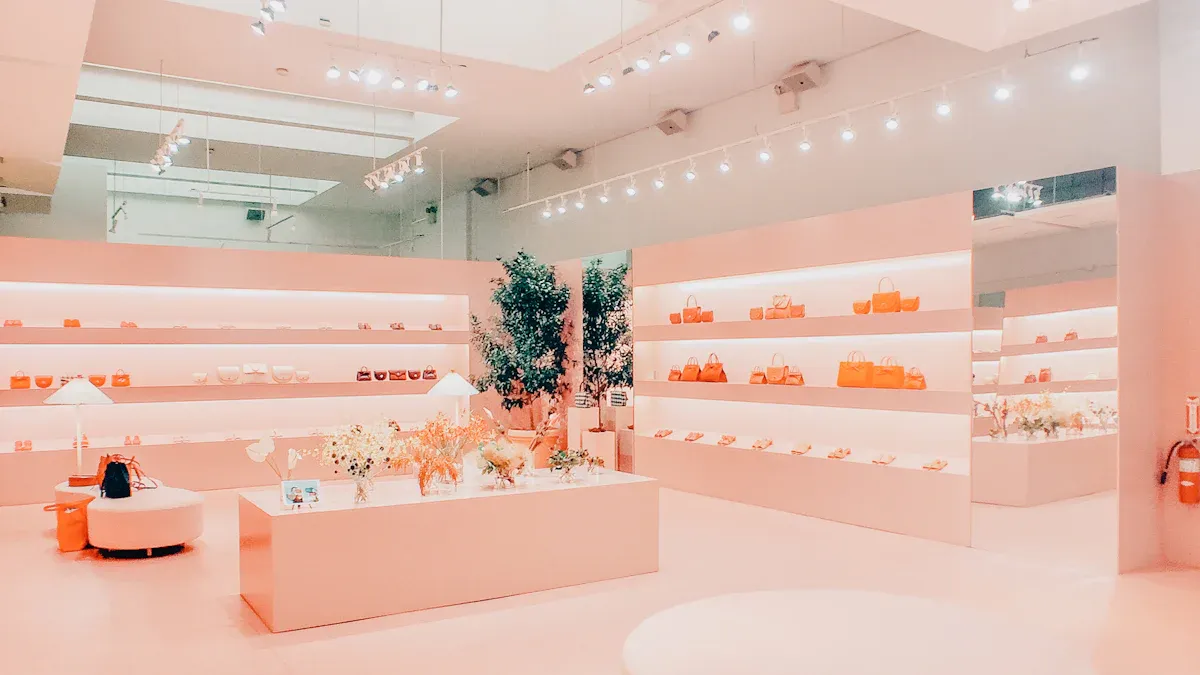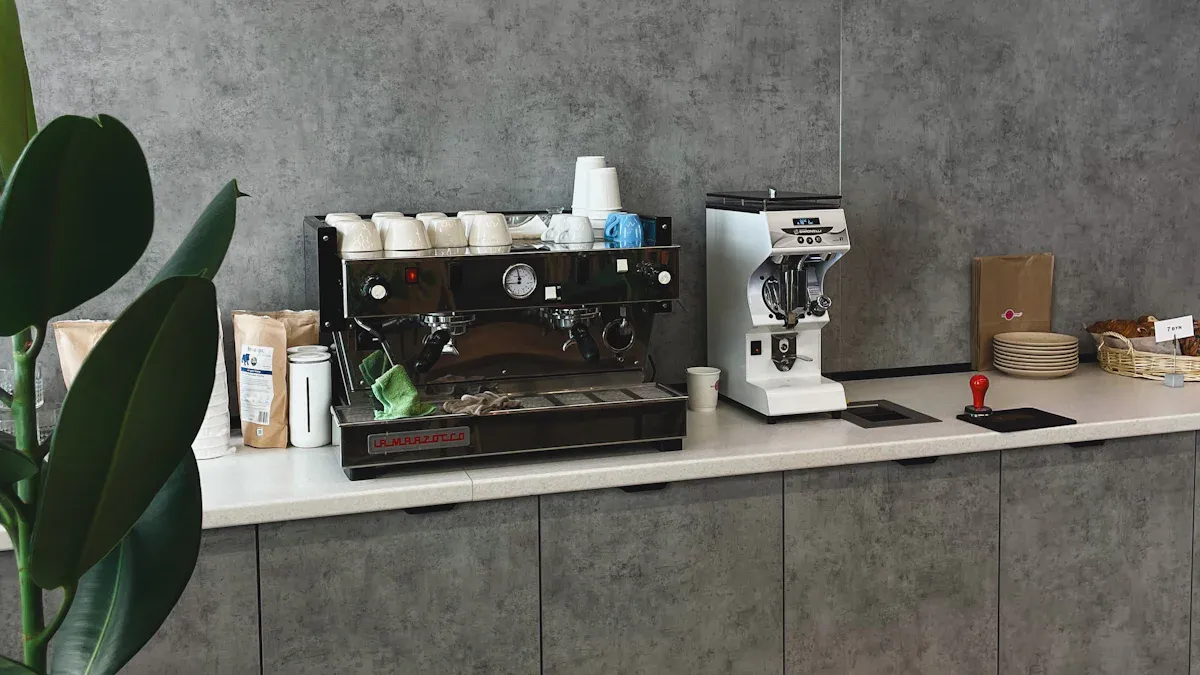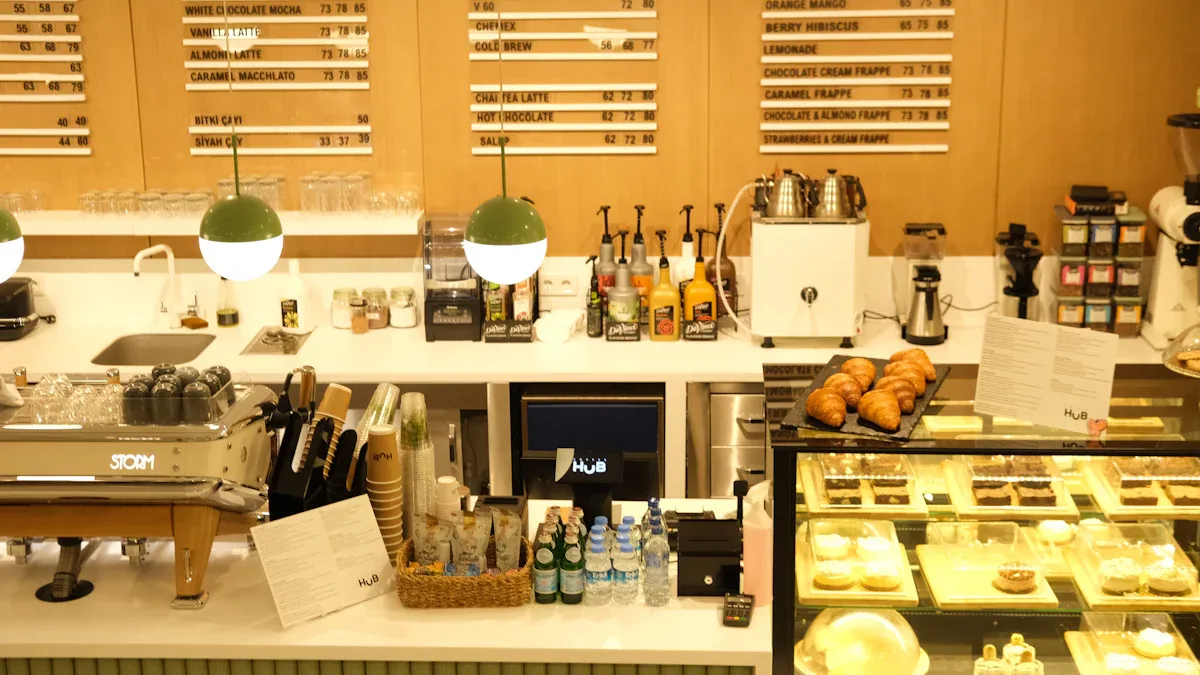Innovative Corner Store Counter Designs for Enhanced Retail Efficiency

In corner store designs, the checkout counter shapes both efficiency and the customer experience. A well-thought-out corner store design ensures smooth operations while leaving a lasting impression on shoppers. You might not realize it, but creative counter setups in corner store designs can boost sales by as much as 30-80%. This happens because custom designs make transactions faster and more enjoyable. For instance, counters featuring real-time promotions or facial recognition technology create a seamless process that satisfies customers.
Functionality plays a vital role in corner store designs. A counter must handle daily tasks while maintaining an appealing look. By blending functionality with aesthetics in your corner store designs, you can craft a space that feels welcoming and works efficiently. Moreover, sustainable materials and energy-saving features add value, ensuring your corner store operates responsibly.
Key Takeaways
Unique counter designs can increase sales by 30-80%. They make shopping quicker and more fun.
Adding tech like self-checkout machines makes things faster. It also helps customers spend less time waiting.
Using space wisely with smart shelves and layouts helps people move easily. This makes shopping better for everyone.
Choosing eco-friendly materials helps the planet. It also brings in shoppers who care about the environment.
Working with design experts makes counters useful and nice to look at. This improves how well the store works overall.
Key Benefits of Corner Store Designs
Boosting Efficiency in Daily Operations
A well-designed convenience store layout can transform daily operations. Logical arrangements of counters and shelves reduce the time staff spends locating items or restocking products. For example, placing high-demand items near the checkout area ensures quick access for both customers and employees. This setup not only saves time but also minimizes disruptions during peak hours.
Operational efficiency improves when you incorporate technology into your store design. Self-checkout kiosks and digital signage streamline processes, allowing staff to focus on other tasks. These innovations also reduce wait times, creating a smoother shopping experience for customers. By boosting efficiency, you can handle more transactions in less time, ultimately increasing profitability.
Enhancing the Customer Experience
Corner store designs play a crucial role in enhancing the customer experience. A well-organized layout ensures that customers can easily find what they need, reducing frustration and encouraging repeat visits. For instance, intuitive store layouts guide shoppers through the aisles, showcasing impulse products and high-demand items along the way. This approach not only improves the shopping experience but also increases sales.
Engagement is another key factor in customer experience enhancement. Interactive displays, such as touchscreens or promotional counters, capture attention and encourage customers to explore more products. Additionally, incorporating comfortable elements like proper lighting and clear signage creates a welcoming atmosphere. When customers feel valued and at ease, they are more likely to spend time in your store and make additional purchases.
Maximizing Space Utilization
Effective corner store designs prioritize maximizing space without compromising functionality. Smart shelving solutions, such as vertical racks, allow you to display more products in a limited area. This approach ensures that every square foot contributes to sales while maintaining an organized appearance. For example, convenience store setup ideas often include modular shelving that adapts to seasonal inventory changes.
A well-planned layout also optimizes customer flow. Placing popular items in accessible locations and using visual merchandising techniques can guide shoppers through the store naturally. Outdoor seating areas, now featured in 75% of newly designed stores, further enhance the shopping experience by providing a space for relaxation. These strategies not only maximize space but also improve customer satisfaction and engagement.
By focusing on point of purchase design, you can highlight key products and encourage impulse purchases. This tactic increases revenue while ensuring that your store remains visually appealing. A thoughtful design balances aesthetics and practicality, creating a space that meets both customer and operational needs.
Creative Ideas for Retail Checkout Counter Designs

Modular and Adaptable Counter Solutions
Modular and adaptable retail counter design offers unmatched flexibility for your store. These counters allow you to reconfigure layouts quickly, making it easier to accommodate new product lines or seasonal changes. For example, modular components like self-scanning apps and marketing tools cater to diverse retail needs. This adaptability ensures your retail checkout counter remains functional and visually appealing, even as your store evolves.
You can also customize modular counters to fit your brand identity. Options like the TCx® SMART design provide advanced security features and AI capabilities, enhancing the checkout experience. By investing in modular solutions, you create a dynamic retail environment that meets both operational and customer demands.
Ergonomic Designs for Staff and Customers
Ergonomic retail counter design prioritizes comfort and safety for both staff and customers. Adjustable counter heights and anti-fatigue mats reduce physical strain, promoting better health outcomes. For instance, ergonomic workstations minimize fatigue and improve cardiovascular health, ensuring your employees stay productive and engaged.
For customers, ergonomic features enhance the personalized checkout experience. Comfortable seating or resting areas near the checkout counters make the shopping process more enjoyable, especially in larger stores. By focusing on ergonomics, you not only improve workplace safety but also create a welcoming atmosphere that encourages repeat visits.
Technology-Driven Checkout Innovations
The future of retail checkout counters lies in technology-driven innovations. Self-service counters equipped with AI-powered POS systems streamline transactions and enhance operational speed. These smart checkout solutions can even recommend products based on customer purchases, boosting sales and creating a more interactive experience.
Contactless payment options, such as NFC-enabled systems, further improve transaction speed and security. Digital displays at the checkout area engage customers, showcasing promotions or product information. Additionally, space-saving checkout counters with integrated technology optimize your store layout while maintaining functionality. By embracing these innovations, you stay ahead in the competitive retail landscape.
Sustainability in Corner Store Counter Designs

Eco-Friendly Materials for Counters
Choosing eco-friendly materials for your counter designs can significantly reduce your store's environmental impact. Many retailers now use reclaimed wood, recycled metals, or bamboo for their counters. These materials not only look appealing but also align with sustainable practices. For example, reclaimed wood adds a rustic charm while reducing the demand for new timber. Recycled metals, on the other hand, provide durability and a modern aesthetic.
Using sustainable materials also benefits your business. It attracts environmentally conscious customers who prefer to shop at stores that prioritize sustainability. Additionally, it enhances your brand image by showcasing your commitment to corporate social responsibility. The table below highlights some key benefits of eco-friendly materials:
Benefit | Description |
|---|---|
Attract environmentally conscious consumers | Aligning with consumer preferences for sustainability invites new customers. |
Achieve cost savings and efficiency improvements | Switching to clean energy reduces overhead costs, especially with rising electricity prices. |
Create a positive brand image | Demonstrating social responsibility appeals to socially conscious investors. |
Energy-Saving Features in Counter Design
Incorporating energy-saving features into your counter designs can lower energy consumption and reduce costs. For instance, using LED lighting in counters minimizes electricity usage while providing bright, efficient illumination. Natural light integration, such as glass ceilings or skylights, reduces the need for artificial lighting during the day. These features not only save energy but also create a pleasant shopping environment.
Energy-efficient systems, like smart temperature controls, further enhance your store's efficiency. These systems adjust energy usage based on real-time needs, cutting unnecessary consumption. By adopting these practices, you can improve your store's property efficiency and reduce its carbon footprint.
Reducing Waste with Smart Design Choices
Smart design choices can help you minimize waste in your store. Modular counters, for example, allow you to adapt layouts without replacing entire units. This flexibility reduces material waste and extends the lifespan of your counters. Additionally, using durable materials ensures your counters withstand wear and tear, reducing the need for frequent replacements.
Employee awareness also plays a role in waste reduction. Training your staff to use resources efficiently, such as turning off unused equipment, can significantly cut energy bills. These small changes, combined with sustainable counter designs, create a more eco-friendly retail environment.
Actionable Tips for Implementing Innovative Counter Designs
Customizing Counters to Match Store Needs
Tailoring your counters to meet the specific needs of your corner store is essential for creating an efficient and customer-friendly environment. Every store has unique requirements based on its size, layout, and target audience. By customizing your counters, you can ensure they align with your operational goals and enhance the shopping experience.
For example, Sephora’s Beauty TIP Workshop transformed traditional counters into interactive zones where customers could test products and receive personalized advice. This innovative approach led to a 35% increase in average transaction value. Similarly, Warby Parker adopted a hybrid retail model by designing gallery-like displays that integrated services, resulting in industry-leading sales per square foot. These examples highlight the importance of designing counters that reflect your store's identity and cater to customer preferences.
To customize your counters effectively, consider the following tips:
Analyze your store's traffic patterns to determine the best counter size and shape.
Incorporate branding elements like colors, logos, or textures to reinforce your store's identity.
Adapt to seasonal changes by using modular counters that can be reconfigured as needed.
Tip: Think about how your counters can serve multiple purposes, such as displaying impulse-buy items or promoting loyalty programs.
Strategic Placement for Optimal Flow
The placement of your counters plays a critical role in optimizing customer flow and ensuring a smooth shopping experience. Strategic counter placement enhances product visibility, reduces congestion, and encourages customers to explore more of your store.
Understanding customer behavior is key to effective counter placement. For instance, Target’s Store Reimagining Initiative introduced curved layouts and dual-entrance designs, which improved customer flow and contributed to a 2-4% sales growth in redesigned locations. Additionally, using AI-driven planograms can help you create layouts that prevent overcrowding and maximize product exposure.
Here are some actionable strategies for strategic counter placement:
Position counters near high-traffic areas to capture customer attention.
Use visual cues, such as signage or lighting, to guide customers toward the checkout area.
Avoid placing counters too close to entrances or exits, as this can disrupt the natural flow of movement.
Note: Strategic placement not only improves efficiency but also creates a more enjoyable shopping experience for your customers.
Collaborating with Design Experts
Partnering with design experts can elevate your store's aesthetic appeal and functionality. Retail designers and visual merchandisers bring valuable insights into creating effective counter designs that align with your brand identity. Their expertise ensures that every element of your store, from materials to lighting, contributes to a cohesive and engaging shopping environment.
For instance, retail designers often collaborate with visual merchandisers to select colors, textures, and materials that reflect a store's message. Lighting specialists can recommend the best lighting solutions based on your store's layout and natural light exposure. These collaborations not only enhance the visual appeal of your counters but also influence customer perception and purchasing behavior.
To make the most of these partnerships:
Communicate your brand vision clearly to the design team.
Involve experts early in the planning process to ensure seamless integration of design elements.
Seek feedback from customers and staff to refine your counter designs over time.
Tip: Collaborating with experts can save you time and resources while ensuring your counters meet both aesthetic and functional goals.
Innovative counter designs transform corner stores by enhancing efficiency, customer experience, and brand representation. These designs optimize space, improve customer flow, and integrate technology for seamless transactions. The table below highlights their key benefits:
Key Area | Description |
|---|---|
Visibility and Accessibility | Enhances customer experiences and increases sales through better customer flow. |
Sustainability | Appeals to eco-conscious consumers and helps meet regulatory standards. |
Operational Efficiency | Optimizes the checkout process, reducing wait times and increasing customer throughput. |
Adopting modern, sustainable solutions ensures your store remains competitive while meeting customer expectations. Thoughtful design choices create a welcoming, efficient space that drives success.
FAQ
What are the key features of a modular counter design?
Modular counters offer flexibility. You can rearrange them to fit new layouts or seasonal needs. They often include customizable components like shelves or display units. This adaptability ensures your store remains functional and visually appealing as your inventory or branding evolves.
How can technology improve checkout counters?
Technology enhances checkout counters by speeding up transactions and improving accuracy. Features like self-checkout systems, AI-powered POS, and contactless payment options reduce wait times. These innovations also create a seamless shopping experience, making your store more efficient and customer-friendly.
Are eco-friendly materials durable for counter designs?
Yes, eco-friendly materials like reclaimed wood, bamboo, and recycled metals are durable. They withstand wear and tear while maintaining their aesthetic appeal. These materials also align with sustainable practices, helping you reduce environmental impact without compromising quality.
How do ergonomic counters benefit staff and customers?
Ergonomic counters improve comfort and safety. Adjustable heights and anti-fatigue mats reduce strain for staff. For customers, features like resting areas or smooth surfaces enhance the shopping experience. These designs promote well-being and encourage repeat visits.
Why is counter placement important in store design?
Strategic counter placement optimizes customer flow and product visibility. Placing counters near high-traffic areas captures attention and reduces congestion. This setup ensures smoother navigation, encourages impulse purchases, and creates a more enjoyable shopping experience.
See Also
Discovering The Elegant Allure Of The Corner Shop
Space-Efficient Snack Vending Machines For Contemporary Areas
How Time Out Corner Shops Are Transforming Urban Convenience
The Growth Of AI-Driven Corner Shops: Insights For Retailers
